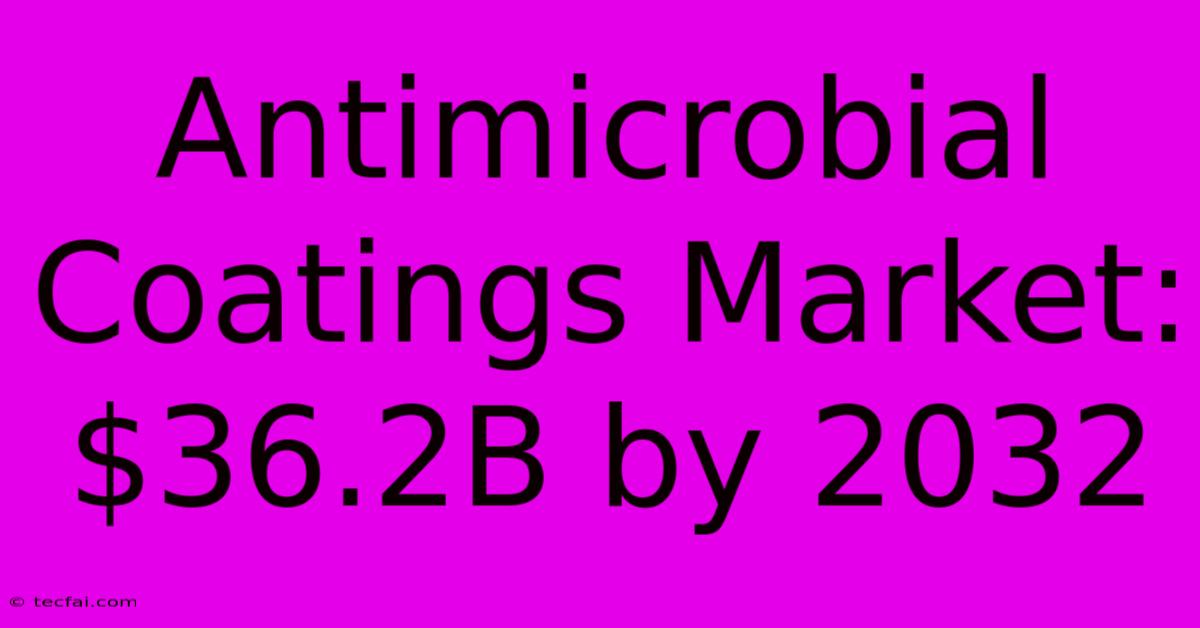Antimicrobial Coatings Market: $36.2B By 2032

Discover more detailed and exciting information on our website. Click the link below to start your adventure: Visit Best Website tecfai.com. Don't miss out!
Table of Contents
Antimicrobial Coatings Market: Poised for Explosive Growth to $36.2B by 2032
The global antimicrobial coatings market is experiencing a period of unprecedented growth, projected to reach a staggering $36.2 billion by 2032. This explosive expansion is driven by a confluence of factors, including rising healthcare concerns, increasing awareness of hygiene, and the escalating demand for infection control across diverse sectors. This article delves into the key market drivers, applications, and future trends shaping this dynamic industry.
Market Drivers: A Perfect Storm for Growth
Several factors are contributing to the phenomenal growth trajectory of the antimicrobial coatings market:
-
Heightened Awareness of Hygiene: The COVID-19 pandemic significantly amplified global awareness of hygiene and infection control. This heightened consciousness is translating into increased demand for antimicrobial coatings in various settings, from hospitals and healthcare facilities to public transportation and residential spaces.
-
Rising Healthcare Associated Infections (HAIs): HAIs pose a significant threat to global health, leading to extended hospital stays, increased healthcare costs, and even mortality. Antimicrobial coatings offer a proactive solution to reduce HAIs by inhibiting the growth of harmful microorganisms on surfaces.
-
Stringent Government Regulations: Governments worldwide are implementing stricter regulations regarding hygiene and infection control, particularly within healthcare facilities. This regulatory pressure is driving the adoption of antimicrobial coatings as a means of compliance and improved patient safety.
-
Technological Advancements: Ongoing research and development are leading to the creation of more effective and durable antimicrobial coatings. Innovations in materials science are resulting in coatings with enhanced antimicrobial properties, broader application capabilities, and longer lifespans.
-
Expanding Applications Across Diverse Sectors: The applications of antimicrobial coatings are expanding beyond healthcare. These coatings are finding increasing use in various sectors, including:
- Construction and Infrastructure: Protecting building materials and surfaces from microbial growth.
- Transportation: Enhancing hygiene in public transportation vehicles and airports.
- Food and Beverage: Maintaining hygiene and extending the shelf life of food products.
- Consumer Products: Incorporating antimicrobial properties into everyday items like kitchenware and textiles.
Types of Antimicrobial Coatings: A Diverse Landscape
The antimicrobial coatings market encompasses a variety of coating types, each with unique properties and applications:
-
Silver-based coatings: Silver nanoparticles exhibit potent antimicrobial properties, making them a popular choice for various applications.
-
Copper-based coatings: Copper and its alloys possess natural antimicrobial properties, offering a sustainable and effective solution.
-
Polymer-based coatings: These coatings offer versatility and can be customized to meet specific application requirements.
-
Other coatings: This category includes coatings based on quaternary ammonium compounds, zinc oxide, and other antimicrobial agents.
Market Segmentation and Geographic Analysis: A Global Perspective
The antimicrobial coatings market is segmented based on several factors, including:
-
Type of coating: As detailed above, this encompasses silver-based, copper-based, polymer-based, and other coatings.
-
Application: This includes healthcare, construction, transportation, food and beverage, and consumer products.
-
Geography: Key regional markets include North America, Europe, Asia-Pacific, and the rest of the world. The Asia-Pacific region is expected to witness significant growth driven by rapid urbanization and rising healthcare expenditure.
Future Trends and Opportunities: Looking Ahead
Several key trends are poised to shape the future of the antimicrobial coatings market:
-
Nanotechnology: The application of nanotechnology will continue to drive innovation in antimicrobial coating development, leading to more effective and durable products.
-
Sustainable Coatings: There is a growing demand for eco-friendly and sustainable antimicrobial coatings, promoting environmentally conscious manufacturing and application.
-
Smart Coatings: The integration of smart technologies into antimicrobial coatings will enable real-time monitoring and control of microbial growth.
The antimicrobial coatings market presents significant opportunities for investors, manufacturers, and researchers. Its continued growth is underpinned by compelling market drivers and innovative technological advancements, positioning it as a key player in the global effort to improve hygiene and public health. As awareness of hygiene continues to rise and technology advances, the market's projected value of $36.2 billion by 2032 seems increasingly achievable.

Thank you for visiting our website wich cover about Antimicrobial Coatings Market: $36.2B By 2032. We hope the information provided has been useful to you. Feel free to contact us if you have any questions or need further assistance. See you next time and dont miss to bookmark.
Featured Posts
-
Diy Tooth Removal Devon Case
Dec 03, 2024
-
Snowden Targets Wolverhampton Win
Dec 03, 2024
-
Gasolina Taas Diesel At Kerosene Baba Dec 3
Dec 03, 2024
-
Supporting New Mothers Why It Matters
Dec 03, 2024
-
First Sentier Investor Leadership Restructure
Dec 03, 2024
